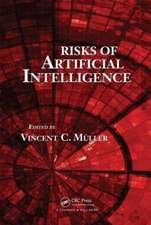Anti-Spam Techniques Based on Artificial Immune System
Autor Ying Tanen Limba Engleză Hardback – dec 2015
Inspired by the biological immune system, the AIS is an adaptive system based on theoretical immunology and observed immune functions, principles, and models for problem solving. Among the variety of anti-spam techniques, the AIS has been highly effective and is becoming one of the most important methods to filter spam. The book also focuses on several key topics related to the AIS, including:
- Extraction methods inspired by various immune principles
- Construction approaches based on several concentration methods and models
- Classifiers based on immune danger theory
- The immune-based dynamic updating algorithm
- Implementing AIS-based spam filtering systems
Anti-Spam Techniques Based on Artificial Immune System gives practitioners, researchers, and academics a centralized source of detailed information on efficient models and algorithms of AIS-based anti-spam techniques. It also contains the most current information on the general achievements of anti-spam research and approaches, outlining strategies for designing and applying spam-filtering models.
| Toate formatele și edițiile | Preț | Express |
|---|---|---|
| Paperback (1) | 342.95 lei 6-8 săpt. | |
| CRC Press – 31 ian 2024 | 342.95 lei 6-8 săpt. | |
| Hardback (1) | 893.82 lei 6-8 săpt. | |
| CRC Press – dec 2015 | 893.82 lei 6-8 săpt. |
Preț: 893.82 lei
Preț vechi: 1303.07 lei
-31% Nou
Puncte Express: 1341
Preț estimativ în valută:
171.09€ • 185.90$ • 143.81£
171.09€ • 185.90$ • 143.81£
Carte tipărită la comandă
Livrare economică 21 aprilie-05 mai
Preluare comenzi: 021 569.72.76
Specificații
ISBN-13: 9781498725187
ISBN-10: 149872518X
Pagini: 264
Ilustrații: 104
Dimensiuni: 156 x 234 x 20 mm
Greutate: 0.52 kg
Ediția:1
Editura: CRC Press
Colecția CRC Press
ISBN-10: 149872518X
Pagini: 264
Ilustrații: 104
Dimensiuni: 156 x 234 x 20 mm
Greutate: 0.52 kg
Ediția:1
Editura: CRC Press
Colecția CRC Press
Cuprins
Anti-Spam Technologies. Artificial Immune System. Term Space Partition-Based Feature Construction Approach. Immune Concentration-Based Feature Construction Approach. Local Concentration-Based Feature Extraction Approach. Multi-Resolution Concentration-Based Feature Construction Approach. Adaptive Concentration Selection Model. Variable Length Concentration-Based Feature Construction Method. Parameter Optimization of Concentration-Based Feature Construction Approaches. Immune Danger Theory-Based Ensemble Method. Immune Danger Zone Principle-Based Dynamic Learning Method. Immune-Based Dynamic Updating Algorithm. AIS-Based Spam Filtering System and Implementation.
Notă biografică
Ying Tan, PhD, is a full professor and PhD advisor in the School of Electronics Engineering and Computer Science at Peking University, China. He is also director of the Computational Intelligence Laboratory at Peking University. He received his PhD from Southeast University in Nanjing, China. His research interests include computational intelligence, swarm intelligence, data mining, machine learning, fireworks algorithm, and intelligent information processing for information security. He has published more than 280 papers, has authored or coauthored six books and more than 10 book chapters, and holds three invention patents. He is editor in chief of the International Journal of Computational Intelligence and Pattern Recognition and is an associate editor of IEEE Transactions on Cybernetics and IEEE Transactions on Neural Networks and Learning Systems. He is the general chair of the ICSI–CCI 2015 joint conference and ICSI series conference and is a senior member of the IEEE.
Descriere
This book introduces research on anti-spam techniques based on the artificial immune system (AIS) to identify and filter spam. It provides a single source of all anti-spam models and algorithms based on the AIS that have been proposed by the author for the past decade in various journals and conferences. It discusses key topics in AIS-based anti-spam techniques, including extraction methods, construction approaches, classifiers based on immune danger theory, and the immune-based dynamic algorithm. It also outlines strategies for designing and applying spam-filtering models.



























